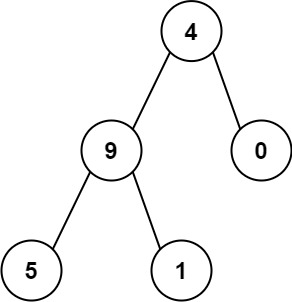No. 129 - Sum Root to Leaf Numbers
====


---
## [LeetCode 129 -- Sum Root to Leaf Numbers](https://leetcode.com/problems/sum-root-to-leaf-numbers/)
### 題目描述
You are given the root of a binary tree containing digits from `0` to `9` only.
Each root-to-leaf path in the tree represents a number.
- For example, the root-to-leaf path `1 -> 2 -> 3` represents the number `123`.
Return the total sum of all root-to-leaf numbers. Test cases are generated so that the answer will fit in a 32-bit integer.
A leaf node is a node with no children.
Example 1.

```
Input: root = [4,9,0,5,1]
Output: 1026
Explanation:
The root-to-leaf path 4->9->5 represents the number 495.
The root-to-leaf path 4->9->1 represents the number 491.
The root-to-leaf path 4->0 represents the number 40.
Therefore, sum = 495 + 491 + 40 = 1026.
```
---
### 解法
本題的目的是把 tree 從 root 到 leaf 看成一個數字然後把每個 root 到 leaf 形成的數字加總起來。
下面為完整的程式碼:
```cpp=
/**
* Definition for a binary tree node.
* struct TreeNode {
* int val;
* TreeNode *left;
* TreeNode *right;
* TreeNode() : val(0), left(nullptr), right(nullptr) {}
* TreeNode(int x) : val(x), left(nullptr), right(nullptr) {}
* TreeNode(int x, TreeNode *left, TreeNode *right) : val(x), left(left), right(right) {}
* };
*/
class Solution {
public:
int dfs(TreeNode* node, int num) {
if (!node)
return 0;
num = 10 * num + node->val;
if (!node->left && !node->right) {
return num;
}
return dfs(node->left, num) + dfs(node->right, num);
}
int sumNumbers(TreeNode* root) {
return dfs(root, 0);
}
};
```
我們可以用 DFS 的方法來解,從 root 一路到 leaf,我們要做的就是把當前走訪的 node 加上前面一路累加起來的結果,也就是說假設到當前 node 為止前面累加起來的數字是 `num` 則 DFS 走訪的當前的 node 會把 `num` 累加為 `num = num * 10 + node->val`,然後再看看有沒有下一個 node 或者當前的 node 就是 leaf,若為 leaf 則回傳當前的 `num` 否則繼續做 DFS。
而最後 DFS 要回傳的是把當前 node 往左右 DFS 回傳的結果相加起來,如此我們就可以把所有 root 到 leaf 的數字加總。
另外我們也要防止當一開始做 DFS 的時候就已經沒有 node,若是這種情況則我們就直接回傳 0。
### 複雜度分析
時間複雜度上,我們要走訪所有的 node 所以複雜度為 $O(N)$。
空間複雜度上,我們需要存 `dfs` 的函式 stack,複雜度為 $O(N)$。